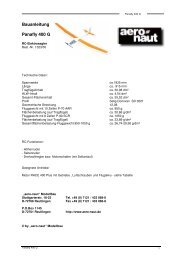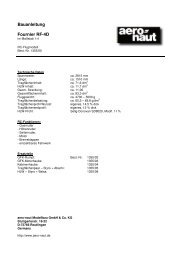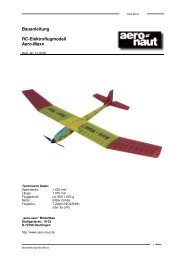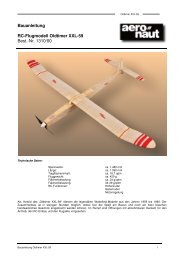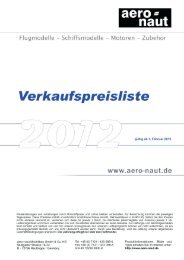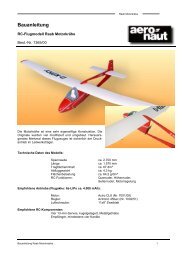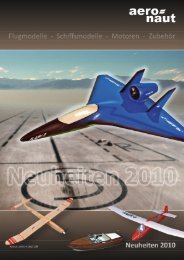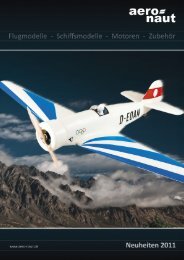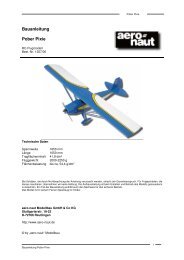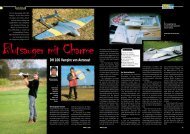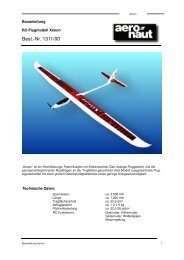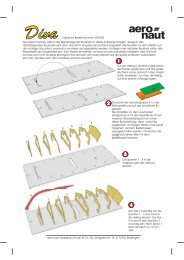Building instructions Fournier RF-4D - Aero-naut
Building instructions Fournier RF-4D - Aero-naut
Building instructions Fournier RF-4D - Aero-naut
Create successful ePaper yourself
Turn your PDF publications into a flip-book with our unique Google optimized e-Paper software.
<strong>Fournier</strong> <strong>RF</strong>-<strong>4D</strong> building <strong>instructions</strong><br />
<strong>Fournier</strong> <strong>RF</strong>-<strong>4D</strong><br />
Cut pieces of aluminium tubing (44) about 5 mm long and press them into the GRP rudder hinge lugs (43).<br />
Trim the slots for the hinge lugs (43) in the tail post and insert them. Take a length of 3 mm Ø steel rod as a<br />
temporary rudder hinge shaft and slide it through the lugs: fit a 2 mm thick spacer (e.g. part 48) between the<br />
trailing edge of the fin and the shaft at the top, and a 3 mm plywood spacer at the bottom. Align the shaft as<br />
accurately as possible (it must be central) and tack parts (43) to the tail post with cyano. Glue the sleeves in<br />
the lugs at the same time - see Fig. 43. Apply a drop of laminating resin to each joint for reinforcement.<br />
Cut four parts from the aluminium tube (44) as shown in Figs. 44 and 45; the bottom piece should project<br />
slightly below the line of the fuselage. Press the rudder (46) against the fin to mark the position of the hinge<br />
lugs (43), and cut the slots for them using a balsa knife - Fig. 46. It should be possible for the whole length of<br />
the rudder leading edge to rest against the tube (44). Fig. 47 shows how the rudder is aligned with the fin.<br />
Position the rudder as accurately as you can, then tack the four pieces of tubing (44) to it using cyano.<br />
Reinforce the joints in the usual way, but not before removing the shaft and rudder - see Fig. 48.<br />
Divide the rudder leading edge (47) as shown in Fig. 49, and cut small recesses to clear the pieces of tube<br />
(44) glued in the hinge lugs (43). Determine the length of the leading edge sections (47) from the rudder<br />
itself, and glue the pieces to the front face of the rudder.<br />
The rudder leading edge should be 8 mm thick at the top, but full thickness (12 mm) at the bottom. Round off<br />
the leading edge step by step as shown in sections D-D and E-E on the plan. The gap between fin and<br />
rudder should be narrow and even, but must permit rudder travels of at least +/- 30° - see Figs. 50 and 51.<br />
Cut a slot for the tailskid actuator (48) using a fine-bladed fretsaw - see fuselage side elevation and section<br />
E-E. File a notch in the front edge of part (48) if necessary to avoid obstructing the rudder hinge shaft (44).<br />
Cut a slot for the rudder horn, but don’t glue it in place until the rudder has been covered; the same applies<br />
to all the control surface horns. Important: all horns (5 off) must be roughened with coarse abrasive paper<br />
before gluing them in their slots. Drill out the linkage holes to 1.6 mm Ø beforehand to accept the clevis pins.<br />
For the tailskid bush (machined aluminium part) drill an 8 mm Ø hole about 48 - 50 mm forward of the tail<br />
end of the fuselage. The coil springs (56) must be installed under light tension. Roughen the bush and degrease<br />
it before fixing it in place with plenty of epoxy.<br />
The fuselage is now almost complete, and we can turn to the fuel supply. If the usual rules are followed<br />
(carburettor level with centreline of fueltank) the usable space for the tank is somewhat restricted. If you wish<br />
to install the tank above the mudguard, it should be of a very low-profile type; a very good choice is the<br />
Simprop “square” type of 340 cc capacity. It has to be located slightly higher than the ideal position, but with<br />
a single-cylinder four-stroke mounted side-winder the carburettor is fairly high in any case - an acceptable<br />
solution.<br />
If you wish to carry more fuel than that, two smaller tanks can be connected in series, as shown on the plan.<br />
In this case you can also set the “ideal” installation height for the actual motor you are using. Important: the<br />
filler / drain line for the system must be sealed for flying (e.g. by fitting an M3 x 10 mm screw in the end).<br />
Oval fueltanks of 240 cc capacity are ideal for the twin-tank arrangement.<br />
The two tailplane panels are glued to the fuselage using a pair of CFRP joiner tubes (60). First cut the tube<br />
(60) in two as shown on the plan, and check that the tubes are an easy sliding fit in the fuselage. Trim the<br />
holes if necessary.<br />
We recommend the following method of gluing the joiner tubes (60) in the fin:<br />
- Apply adhesive tape over the moulded-in tailplane root fairings and apply a coat of mould-release wax to<br />
the tape. Open up the holes using a sharp balsa knife.<br />
- Glue pieces of balsa in both ends of the tubes (60) to seal them.<br />
- The front joiner tube (60) should now be glued in (say) the left-hand tailplane panel, the rear tube in the<br />
right-hand panel using thickened laminating resin. This is the procedure:<br />
- Apply plenty of epoxy to the inside of the holes and distribute it carefully using a length of dowel or steel<br />
rod. Slowly push the tube into the hole, twisting it to and fro as you do so. Watch the depth! If no epoxy is<br />
squeezed out of the root rib, apply more epoxy. Remove excess resin then clean any excess epoxy from<br />
the tube using acetone.<br />
- Now leave the epoxy to semi-harden; the time this takes depends on the room temperature. The tubes<br />
should now be slightly difficult to move. At this point fit both tailplane panels into the fuselage, align them<br />
7



